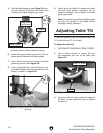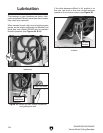
-40-
G8144Z/G8145Z/G8146Z
Vertical Metal Cutting Bandsaw
Motor & Electrical (continued)
Symptom Possible Cause Possible Solution
Machine has vibra-
tion or noisy opera
-
tion.
1. V-belt(s) worn or loose.
2. Pulley is loose.
3. Motor mount loose/broken.
4. Machine is incorrectly mounted or sits
unevenly.
5. Workpiece is loose.
6. Motor fan is rubbing on fan cover.
7. Motor bearings are at fault.
8. Blade is at fault.
9. Blade wheels out of alignment.
1. Inspect/replace belts with a new matched set (
Page
41).
2. Realign/replace shaft, pulley, set screw, and key as
required.
3. Tighten/replace.
4. Tighten/replace anchor studs in floor; relocate/shim
machine.
5. Use the correct holding fixture and reclamp
workpiece.
6. Replace dented fan cover; replace loose/damaged
fan.
7. Test by rotating shaft; rotational grinding/loose shaft
requires bearing replacement.
8. Re-tension/replace blade (
Pages 28 & 29).
9. Re-align blade wheels (
Page 42).
Cutting Operations
Symptom Possible Cause Possible Solution
Machine slows when
operating.
1. Feeding workpiece too fast.
2. Blade is dull.
1. Reduce feed rate/increase blade speed.
2. Replace blade (
Page 28).
Ticking sound when
the saw is running.
1. Blade weld contacting blade guide/support
(a light ticking is normal).
2. Blade weld may be failing.
1. Inspect/re-grind blade weld (
Page 33); re-adjust
blade guides/support (
Page 31).
2. Inspect weld and re-weld blade if necessary (
Page
33), or replace blade (Page 28).
Blade contacting
table.
1. Table improperly mounted or aligned. 1. Properly align table (
Page 44).
Vibration when cut
-
ting.
1. Workpiece is loose.
2. Loose or damaged blade.
3. Metal chip buildup on wheels.
1. Use the correct holding fixture and reclamp
workpiece.
2. Re-tension/replace blade (
Pages 28 & 29).
3. Clean metal chips from wheels.
Rough or poor qual
-
ity cuts.
1. Feeding workpiece too fast.
2. Incorrect blade for operation; worn or dam
-
aged blade.
3. Blade guides/support adjusted incorrectly.
1. Reduce feed rate/increase blade speed.
2. Use the correct blade for the operation (
Page 23);
replace worn or damaged blade (
Page 28).
3. Correctly adjust blade guides/support (
Page 31);
set the blade guides approximately 1/8" above
workpiece.
Blade wanders or
doesn't cut straight.
1. Blade lead.
2. Metal chip buildup on wheels.
1. Re-tension/replace blade (
Pages 28 & 29).
2. Clean metal chips from wheels.
Cuts are not square
(vertically).
1. Table tilt is not adjusted to "0".
2. Table is not square to the blade.
1. Adjust table to "0" tilt.
2. Adjust table square with blade (
Page 44).
Wheel is noisy. 1. Wheel bearing is worn out.
2. V-belt is too tight (lower wheel).
1. Replace wheel bearing.
2. Check/re-tension the V-belt (
Page 41).
Blade does not track
consistently, cor
-
rectly, or at all.
1. Wheels are not coplanar or aligned with
each other.
2. Rubber tires on wheels are worn out.
1. Adjust wheels to be coplanar/aligned with one
another (
Page 42).
2. Redress the rubber tires on the wheels (
Page 37).


















